Gallery
- The golden window that is opened once a year.
- Newar musicians performing
| Etymology | Dance performed in the month of Kartika |
|---|---|
| Genre | Nepalese folk dance |
| Year | 1641 |
| Origin | Lalitpur |
Kartik Naach (Nepali : कात्तिक नाच, also known as Kachhalā Pyākhan (Nepal Bhasa: कछला प्याखं)), is a dance musical play that is performed every month of Kartik (October or November) in Nepal. [1] It was started in 1641 AD by Nepali Malla King Siddhi Narsingh Malla. [2] [3] [4] The play is performed in Kartik Dabali, Patan Durbar Square every year. [3] [5]
It is usually presented for two to 27 days with 17 tales of Hindu god Vishnu. [3] [4] Originally it was shown for two days, but Narsingh Malla's son Shree Niwas Malla added seven days, and Narsingh Malla's grandson Yog Narendra Malla added 15. [4]
The play was preserved by Kartik Naach Prabandhan Samiti, but the Kartik Nach Preservation Committee (KNPC) has been preserving it since 2013. [3] The play usually starts with dancers in colourful clothes portraying Hindu deities including Barahi, Ganesh, Shiva, and Krishna. [4] The dancers also wear festoons around their necks. [4] It is performed by Newar people and in 2015, there were "45 musicians and 10 helpers" performing. [4]
It is also performed near the golden window in Patan and the window is opened only at the play. Legends say that it was built to honour the King Siddhi Narsingh Malla. [6] [7] Most of the dances and music is thought to have been composed by Narsingh Malla, but there have been minor changes to it. [8] Hari Man Shrestha, previously a director of KNPC, has penned a book on the play. [8]
The April 2015 Nepal earthquake critically damaged Patan Durbar Square.[ citation needed ] Seven months later, Kartik Naach was performed for 10 nights, while it was still damaged.[ citation needed ] Xinhua News Agency wrote, "Despite the tragedy, thousands of Nepali people, young and old, trooped to the temple to watch the open-air presentation of the historical dance-drama to the accompaniment of folk music".[ citation needed ] In 2018, Lalitpur had distributed 200,000 Nepalese rupees to the play. [2]

Kathmandu, officially the Kathmandu Metropolitan City, is the seat of federal government and the most populous city in Nepal. As of the 2021 Nepal census, there were 845,767 inhabitants living in 105,649 households and approximately 4 million people in its surrounding agglomeration. It is located in the Kathmandu Valley, a large valley surrounded by hills in central Nepal, at an altitude of 4,344 feet above sea level.
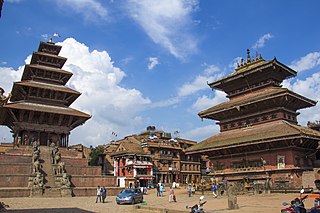
Bhaktapur, known locally as Khwopa and historically called Bhadgaon, is a city in the east corner of the Kathmandu Valley in Nepal located about 13 kilometres (8.1 mi) from the capital city, Kathmandu. Bhaktapur is the smallest city of Nepal as well as the most densely populated. Along with Kathmandu and Lalitpur, Bhaktapur is one of the three main cities of the Kathmandu Valley and is a major Newar settlement of the country. The city is also known for its Newar tradition, cuisine and artisans. Bhaktapur suffered heavy damage in the April 2015 earthquake.

Newar, or Nepami, are primarily inhabitants in Kathmandu Valley of Nepal and the Indian territories of Sikkim state and Gorkhaland including its surrounding areas and the creators of its historic heritage and civilisation. The Newar are a distinct linguistic and cultural group, primarily Indo-Aryan and Tibeto-Burman ethnicities, who share a common language, Nepal Bhasa, and predominantly practice Newar Hinduism and Newar Buddhism. Newars have developed a division of labour and a sophisticated urban civilisation not seen elsewhere in the Himalayan foothills.
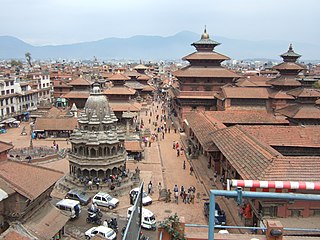
Lalitpur Metropolitan City, also known as Patan, Yala, and Manigal, is a metropolitan city and fourth most populous city of Nepal with 299,843 inhabitants living in 49,044 households per the 2021 census. It is located in the south-central part of Kathmandu Valley, a large valley in the high plateaus in central Nepal, at an altitude of 1,400 metres.

The Kathmandu Valley, also known as the Nepal Valley or Nepa Valley, National Capital Area, is a bowl-shaped valley located in the Himalayan mountains of Nepal. It lies at the crossroads of ancient civilizations of the Indian subcontinent and the broader Asian continent, and has at least 130 important monuments, including several pilgrimage sites for Hindus and Buddhists. The valley holds seven World Heritage Sites within it.

The Malla dynasty also known as the Malla confederacy, was the ruling dynasty of the Kathmandu Valley in Nepal from 1201 to 1779. This dynasty was founded by Arideva Malla. Though the latter Mallas were regarded as belonging to the Raghuvamsha dynasty, they were also seen as continuations and descendants of the Licchavi dynasty. Later Malla kings also traced one section of their lineage from Nanyadeva, the founder of the Karnat dynasty of Mithila. The term malla means wrestler in Sanskrit. The first use of the word malla in the Kathmandu Valley began in 1201.

A dhunge dhara or hiti is a traditional stone drinking fountain found in Nepal. It is an intricately carved stone waterway through which water flows uninterrupted from underground sources. Dhunge dharas are part of a comprehensive drinking water supply system, commissioned by various rulers of Ancient and Medieval Nepal. The system is supported by numerous ponds and canals that form an elaborate network of water bodies, created as a water resource during the dry season and to help alleviate the water pressure caused by the monsoon rains. After the introduction of modern, piped water systems, starting in the late 19th century, this old system has fallen into disrepair and some parts of it are lost forever. Nevertheless, many people of Nepal still rely on the old dhunge dharas on a daily basis.
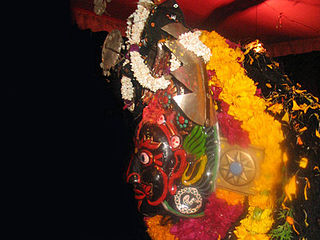
Bhairab Pyankhan. "Bhairava's Dance" is an ancient masked dance performed by Newar community in the Pokhara Valley of Nepal as part of the Bhairab Jatra festival and named after Bhairab Bhairava, an aspect of Shiva.

Madhyapur Thimi, also known as Thimi, is a municipality in Bhaktapur District in the Bagmati Zone of central Nepal. Thimi lies between Kathmandu, Lalitpur and Bhaktapur in the Kathmandu Valley. It is one of the ancient cultural and historical places along the trade route from Bhaktapur to Kathmandu. The city is situated on elevated land and occupies an area of 11.47 square kilometres (4.43 sq mi), divided into nine administrative wards.

Bhupatindra Malla was a Malla Dynasty King of the Kingdom of Bhaktapur who reigned from 1696 until his death in 1722. He is the most widely known king of Bhaktapur and is among the most popular of the Malla dynasty. He is popularly known in Bhaktapur as nepaḥ juju, meaning the king of the Newars. His reign was characterized by the construction of numerous palaces and temples with the Nyatapola temple being his most revered contribution. An integral part of the local folklore, Bhupatindra Malla is regarded as a great builder and a lover of arts whose reign is considered the cultural high point of Bhaktapur. In particular, he was a scholar of the Maithili language and composed 26 plays in Maithili throughout his lifetime.

Bhaktapur Durbar Square is a former royal palace complex located in Bhaktapur, Nepal. It housed the Malla kings of Nepal from 14th to 15th century and the kings of the Kingdom of Bhaktapur from 15th to late 18th century until the kingdom was conquered in 1769. Today, this square is recognised by UNESCO, managed jointly by the Archeological Department of Nepal and Bhaktapur Municipality, and is undergoing extensive restoration due to the damages from the earthquake in 1934 and the recent earthquake of 2015.
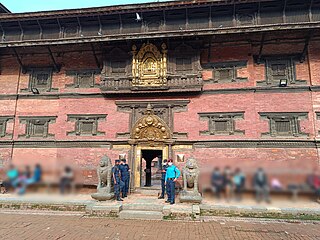
Patan Durbar Square is situated at the centre of the city of Lalitpur in Nepal. It is one of the three Durbar Squares in the Kathmandu Valley, all of which are UNESCO World Heritage Sites. One of its attractions is the medieval royal palace where the Malla Kings of Lalitpur resided.
Rajopadhyaya also called Newari Brahmin is the main division of Newar Brahmins in Nepal. The Rajopadhyayas claim to be originated in Kānyakubja or modern day Kannauj, in the north of India, a city with a prestigious history from where the Bahuns also claim to come. They along with Bahuns claim to be sub-division of Kānyakubja Brāhmins.
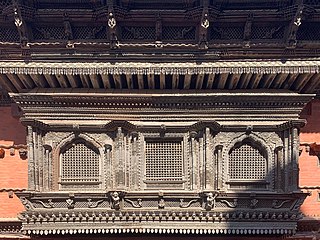
Newār window refers to the elaborately carved wooden window which is the distinguishing feature of traditional Newa architecture. The ornate windows have been described as a symbol of Newar culture and artistry. The level of design and carving of the Newar window reached its peak in the mid-18th century. They are found on palaces, private residences and sacred houses across Nepal Mandala.

The Battle of Lalitpur in 1768 ended with the Gorkha conquest of Lalitpur, one of the three kingdoms in Nepal centered in the Kathmandu Valley, and the loss of the rule of the native Newars.

Dance is a performing art form consisting of purposefully selected sequences of human movement. Dance (Nepali: नृत्य/ नाच) in Nepal comprises numerous styles of dances, including folk, ethnic, classical to modern dances. Lakhey is the dance of a demon in the carnival of God. Durbar Square, a historic plaza in Kathmandu, Nepal, facing ancient palaces and adorned by Hindu temples, is always full of eager crowds on the last day of Indra Jatra, the festival celebrating Indra, the Hindu king of heaven. In this divine stage, Lakhe the demon dances among gods and deities relentlessly and carelessly.

The Tusha Hiti, also known as Royal Bath, is a sunken bath used by the Malla royal family in Nepal. It is at the courtyard of Sundari Chowk, Patan Durbar Square, Lalitpur. King Siddhinarasimha Malla is credited with building the bath in the 17th century. The wall features idols of Ashta Matrikas, eight Bhariavs and Nagas, and the gilt copper spout features idols of Vishnu and Laxmi residing on Garuda. The Tusha Hiti is shaped like a yoni and can be accessed via its main entrance from the western façade.

Krishna Mandir is a 17th-century Shikhara-style temple built by King Siddhi Narsing Malla. It is located at the Patan Durbar Square, a UNESCO World Heritage Site, in the city of Lalitpur in Nepal. It was damaged by the Nepal earthquake of April 2015, and was later restored in 2018.
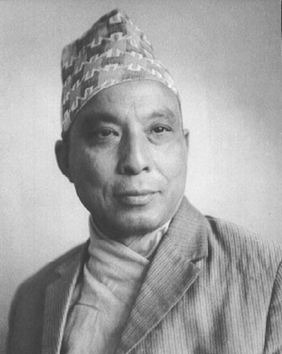
Bijaya Malla was a Nepalese poet, novelist and playwright. Malla wrote multiple novels, plays and poems in his lifetime. He is best known for his novels like Anuradha and plays like Koi Kina Barbaad Hos, Baula Kaji ko Sapana and Dobhan.